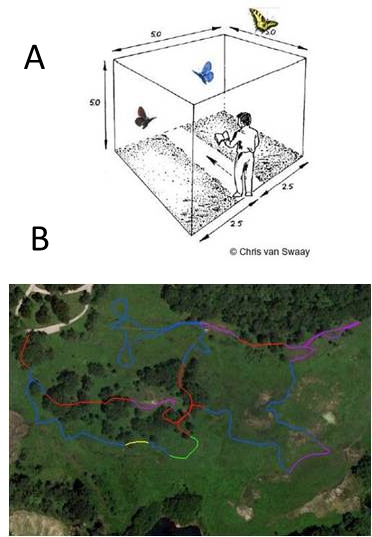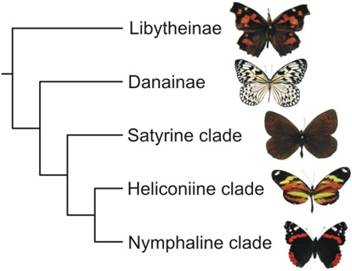
Our network of monitoring programs includes multiple protocols with substantial variation between and some even within types. Our goal is not to try to shoehorn all the projects into one standard, but we encourage standardization where possible and document all differences. One way that we encourage standardization is to work with new programs as they develop their protocols. For now, anyone interested in starting a new program should contact Jeff Pippen (at the Carolinas Butterfly Monitoring Program) or Doug Taron (at the Illinois Butterfly Monitoring Network). We provide expertise for new programs to help them with protocols, data standards, data management, and volunteer management.
STANDARDIZING PROTOCOLS: The program we use with the strictest protocols are transects. Almost all transect programs follow some modified version of a "Pollard walk" (Panel A to left) and define set routes (example route map in Panel B). These are the primary data we support on a daily basis, through this network and the Pollardbase system for data management. We also maintain long-term collaborations with the North American Butterfly Association and other groups with counts and opportunistic programs, which have few protocols.

Transect protocols may vary depending on how wide the observation buffer (size of box in Panel A), the walking pace, whether the survey is timed, whether there are helper recorders, what types of evironmental data are collected for each trip, etc. By capturing differences between protocols, we are able to integrate data for analysis while taking into account the differences in data collection. While we will continue to encourage standardizing protocols where possible (especially for new programs), program differences are formally captured by meta-data, which we focus on in Goal 3. We also keep a record of protocol differences through our information on our Monitor Tracker.
RESOLVING TAXONOMIES (BUTTERFLY NAMES): One critical challenge to integrating these data for large-scale analysis is resolving the different naming conventions of different groups, which arise for many reasons. To use our data management system, each monitoring program must identify a taxonomic standard for use in its survey data. We have developed a names system which provides two widely adopted baseline taxonomies: the NABA checklist, and the Pelham system. Each monitoring program has identified one baseline taxonomy, and then declared any variances from that taxonomy, as part of its documentation. The North American Butterfly Monitoring Program developed a tool to resolve differences between taxonomic standards so data are interoperable (see Goal 6). This work was published in the scientific literature in 2020 (https://doi.org/10.7717/peerj.9219).
